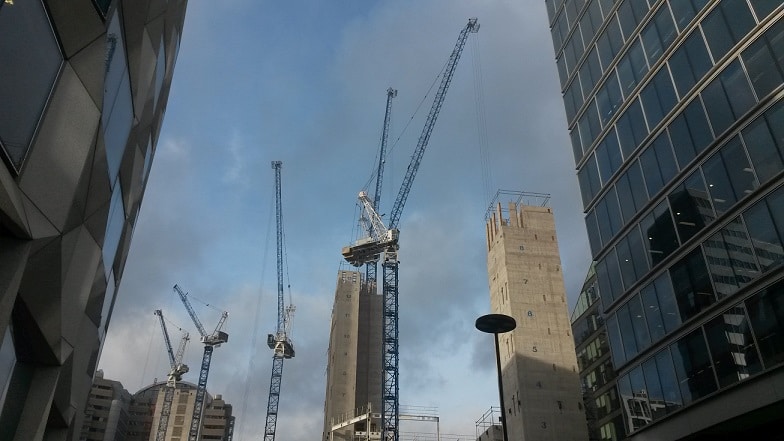Despite the ups and downs – a strong first half, a slowdown in the third quarter and weakness in early data for Q4 – construction industry output in 2015 was estimated to have expanded by a healthy 3.9 per cent to reach £131.6 billion, according to the Construction Products Association’s latest winter forecast. CPA economist Amandeep Bahra looks at 2016 and beyond.
Even though 2015 output was strong, expanding at a healthy 3.9 per cent, construction output for this year is forecast to grow only 3.6 per cent, down from the 3.8 per cent predicted in the CPA’s autumn forecast. This downward revision primarily reflects the weakness in private housing repair, maintenance and improvement (RM&I) and in commercial retail.
Beyond 2016, the outlook appears bright for the construction industry, with growth rates revised up for each year until 2019. In 2019, construction output is projected to reach a value of £153.9 billion, which is 15.3 per cent higher than its pre-recession level in 2007.
So, what is the outlook for key sectors?
More or less the same for housing
Without doubt, the housing sector will remain among the key players. This will be led by the private housing sector, with output estimated to have risen 7.0 per cent in 2015 and starts up by 5.0 per cent. Looking ahead, the conditions for the private housing sector will more or less remain the same as 2015. First, government policies such as Help to Buy schemes will continue to stimulate demand, while housing supply will remain constrained. Second, problems surrounding the recruitment of skilled labour and the inevitable feed-through into higher costs for house builders are likely to hold back the sector’s ability to deliver on housing numbers.
Despite this, there is still a degree of optimism for the medium-term and, as a result, we expect output in the private housing sector to grow 5.0 per cent in both 2016 and 2017. For 2017, this is an upward revision compared to the 2.0 per cent projected in the autumn forecast, reflecting the increased government stimulus underpinning demand.
Regional markets remains attractive
The overall picture for commercial will broadly remain the same, with growth unsurprisingly led by the offices subsector. As in 2015, activity will continue to increase outside of London, particularly in Manchester and Birmingham, as companies and investors look to expand beyond the capital. In Birmingham, 969,000 sq. ft of office space is currently under construction, with development at its highest in 13 years, according to Deloitte’s latest Birmingham Crane Survey. This includes some of the largest projects such as the 210,000 sq. ft head office for HSBC at Arena Central and the £500 million redevelopment of Paradise Circus. In addition, work on Birmingham’s tallest building, which will provide 150,000 sq. ft of office space and forms part of the £200 million Beorma Quarter development in Digbeth, is expected to start this year.
Despite increased investor interest in regional markets, London will still provide some support to the subsector. On one hand the economic backdrop remains largely supportive, with business investment and employment levels strong. On the other hand, the London offices market remains highly exposed to the uncertainty in the global economy. In addition to this, new orders fell 18.6 per cent in 2015 Q3, a second consecutive quarterly contraction, reflecting cost pressure on developers. So, are we likely to see growth rates ease? Is it time to call caution for the London offices market? Setting aside these concerns, the pipeline appears strong in the capital, with major projects underway, including the 867,000 sq. ft 100 Bishopsgate and 120 Fenchurch Street. Overall, across Great Britain, offices output is forecast to grow 7.0 per cent in both 2016 and 2017.
A retail surprise?
In the retail subsector, despite favourable economic conditions and growth led by consumer spending, output was estimated to have contracted by 10.0 per cent in 2015. For this year, no growth is forecast, followed by 2.0 per cent growth in 2017. Asda is expected to slow expansion of small convenience stores in London and hold back 1,000 click-and-collect sites across the UK by 2018, instead planning to refurbish 95 large existing stores. In contrast, discount retailers are continuing recent strategies to gain market share through expansion. Aldi, for example, expects to open 80 new stores in 2016, part of its plan for 1,000 stores to be delivered by 2022.
Despite the mixed picture for supermarkets, previously a strong driver of retail construction growth, major shopping centre expansions, such as the £400 million redevelopment of Oxford Westgate and the £1 billion redevelopment of Croydon’s Whitgift shopping centre, will also contribute to growth.
Spotlight remains on warehouses
Strong growth of online shopping has also meant that activity remains skewed towards the warehouses industrial subsector. In December, on a yearly basis, online retail sales rose 8.2 per cent, whereas overall retail sales fell by 1.0 per cent. Given the increase in online retail, there is widely expected to be a structural change in the retail industry in the next ten years. Reflecting this underlying demand, warehouse take-up levels reached 17.5 million sq. ft in the first three quarters of 2015, which is one million above the long-term average, according to Savills. With this trend expected to continue, the warehouses subsector is forecast to grow 10.0 per cent in 2016 and 5.0 per cent in 2017.
All in all, the outlook for construction appears optimistic. With continued growth expected in housing and offices, the prospects for the supply chain remain bright. We hasten to point out, however, that key risks remain, notably around skills shortages and labour costs which are already impacting projects. Piling on to the challenges, uncertainty around the global economic growth, particularly the weakness in China and uncertainty regarding the EU referendum, are posing a downside risk over the forecast period.


